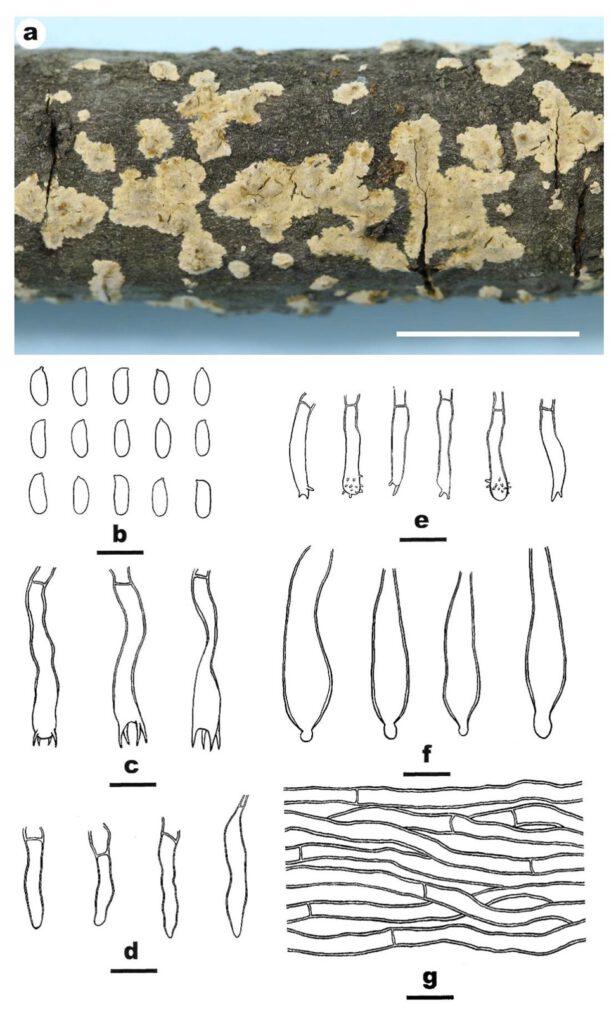Acanthostereum effusum S.H. He & Y.F. Cao, sp. nov.
MycoBank number: MB; Index Fungorum number: IF; Facesoffungi number: FoF 10783;
Description
Sexual state: Fruiting body – Basidiomata annual, resupinate, effused, adnate, inseparable from substrate, coriaceous, first as small colonies, later confluent up to 5 cm long, 2 cm wide, 100–150 μm thick. Hymenophore smooth, pale orange (5A3), light orange [5A(4–5)] to greyish orange [5B(3–6)], turning light brown in KOH, uncracked; margin thinning out, slightly fimbriate, indistinct, concolorous with hymenophore. Microscopic structures – Hyphal system monomitic; all hyphae without clamps. Subiculum indistinct; hyphae colorless, slightly thick-walled, smooth, rarely branched, moderately septate, more or less parallel to substrate, 2.5–5 µm in diam. Subhymenium distinct; hyphae colorless, thin- to slightly thick-walled, smooth, densely interwoven, 2–3.5 μm in diam. Cystidia of three kinds: (1) pseudocystidia (gloeocystidia) scattered, subclavate to subcylindrical, with a papilla at the apex, colorless to pale yellow, slightly thick-walled, smooth, mostly embedded, up to 100 µm long, 7–10 µm wide; (2) acutocystidia numerous, subulate, colorless, thin-walled, smooth, 15–20 ´ 3–4.5 µm; (3) acanthocystidia (acanthophyses), clavate or hyphoid, with few to many spines at the apex, colorless, thin-walled, 18–26 ´ 3.5–6 µm. Basidia cylindrical to clavate, colorless, slightly thick-walled toward the base, with 4 sterigmata and a basal simple septum, 30–35 ´ 4–4.5 µm; basidioles dominant, in shape similar to basidia, but slightly smaller. Basidiospores oblong ellipsoid to subcylindrical, colorless, thin-walled, smooth, amyloid, acyanophilous, 7.5–10 ´ 2–3.5 µm, L = 8.4 µm,W = 2.9 µm,Q = 2.9 (n = 30/1).. Asexual state: not observed.
Material examined: CHINA, Yunnan Province, Kunming, Yeyahu Park, on fallen angiosperm branch, 22 August 2015, He 2526 (BJFC 020979, holotype, isotype in BJM) & He 2514 (BJFC 020967).
Distribution: China
Sequence data: LSU: MW528911 (LROR/LR7)
Notes: Acanthostereum effusum is characterized by the resupinate and pale yellow basidiomata, papillate skeletocystidia and numerous acanthophyses. Acanthostereum wakullum is similar to A. effusum by sharing the resupinate basidiomata, presence of three kinds of cystidia and same size of basidiospores but differ in having longer acutocystidia (20–40 µm), less distinct papillate skeletocystidia and a distribution in southern USA (Burdsall et al. 1981; Boidin et al. 1997). Moreover, the two species are recognized as independent lineages in the phylogenetic tree.

Fig. 2. Acanthostereum effusum (BJFC 020979, holotype). a Basidiomata. b Basidiospores. c Basidia. d Acutocystidia. e Acanthocystidia. f Pseudocystidia. g Hyphae from subiculum. Scale bars: a = 1 cm, b–g = 10 µm.
